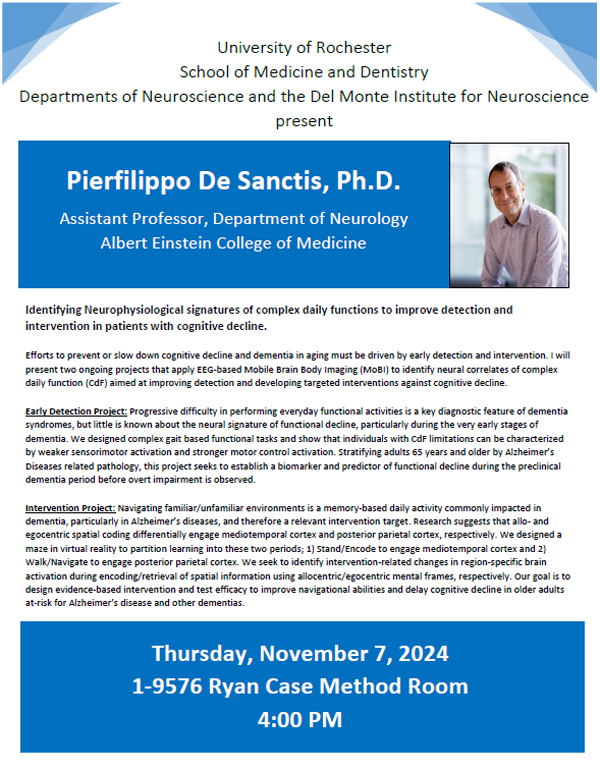Visiting Speakers
Connecting the dots between brain microstructure, function, and behavior in rodents using MRI
Tanzil Arefin, PhD - Assistant Research Professor, Biomedical Engineering, Penn State College of Engineering
Jan 30, 2024 @ 4:00 p.m.
Medical Center | Ryan Case Method Rm. (1-9576)
Host: Department of Neuroscience and the Del Monte Institute for Neiroscience
A Novel Form of Brain Dynamics and Direct Interoception: Rapid, Local BBB Permeability at Key Behavioral Moments and in Response to Dopamine Axon Signaling
Christopher Moore, PhD - Professor of Neuroscience, Associate Director, Carney Institute for Brain Science, Brown University
Oct 24, 2024 @ 9:30 a.m.
Choosing correct actions, and learning from them, requires knowledge of current biological needs. Signals carried within vessels are a high-dimensional, unfiltered source of internal state information. However, the Forebrain blood-brain barrier (BBB) is typically thought to restrict access to almost all such signals. This restriction is viewed as crucial, as sustained BBB weakening is a major health risk, a hallmark of neurodegenerative disease.
Here, we report a (potential) resolution to this paradox. We have found that the BBB is dynamic, providing increased access to vascular input, but only briefly and locally, and only when higher quality body signals would be worth the risk. Specifically, brief moments of BBB permeability ('Plume Events') are aligned to key behavioral events (e.g., Cue, Reward) with sub-second precision. While many brain and vascular signals may control Plume Events, the Ventral Tegmental Area (VTA) is ideally positioned for this role, as its activity indexes behavioral relevance and its Axons target Forebrain vessels. Optogenetic activation of Dopaminergic (DA) VTA Axons drives Plume Events, DA agonists drive similar rapid permeability increases, and endogenous spiking by VTA DA axons predicts Plume Events, with Axons contacting Arterioles having strongest impact. Spiking in a subset of VTA Axons also predicts preceding Plume Events, indicating vascular signals may drive local neural activity. Across Tasks and Plume Event size, Plume Events show consistent onset dynamics, fast expansion for ~500 ms followed by a plateau.
These findings support a new communication mechanism for real-time adaptive behavior, and the prediction that rapid vascular dynamics play an active role in Forebrain computation (the 'Hemo-Neural' Hypothesis, Moore and Cao, 2008). Brief BBB permeability tuned to local activity could also have other potential benefits, including metabolic ‘microsupply’ delivered at the time and place where it is needed.
Medical Center | K307 (3-6408)
Host: BCS/NSC Joint Colloquium
Identifying neurophysiological signatures of complex daily functions to improve detection and intervention in patients with cognitive decline
Pierfilippo De Sanctis, PhD - Assistant Professor, Department of Neurology, Albert Einstein College of Medicine
Nov 07, 2024 @ 4:00 p.m.

Medical Center | Ryan Case Method Rm (1-9576)
Host: UR School of Medicine and Dentistry, Department of Neuroscience, and the Del Monte Institute for Neuroscience